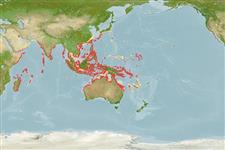Hexacorallia |
Scleractinia |
Lobophylliidae
Environment: milieu / climate zone / depth range / distribution range
Ecology
Reef-associated; depth range 0 - 30 m (Ref. 98471). Tropical; 36°N - 27°S, 103°E - 178°W
Western Pacific: Indonesia to Melanesia, north to Japan and south to Queensland, Australia.
Length at first maturity / Size / Weight / Age
Maturity: Lm ? range ? - ? cm
Formation: cerioid, with neat angular corallites up to 8 mm in diameter. Septa with 1 to 3 teeth. Mantle: thick and fleshy, usually covered with fine papillae. Color: gray, except in Japan where it is brick red or green (Ref. 848).
Occurs in protected reef environments and rocky foreshores (Ref. 848).
Life cycle and mating behavior
Maturity | Reproduction | Spawning | Eggs | Fecundity | Larvae
Members of the class Anthozoa are either gonochoric or hermaphroditic. Mature gametes are shed into the coelenteron and spawned through the mouth. Life cycle: The zygote develops into a planktonic planula larva. Metamorphosis begins with early morphogenesis of tentacles, septa and pharynx before larval settlement on the aboral end.
Veron, J.E.N. 2000 Corals of the world. Volume 3. Australian Institute of Marine Science and CRR Qld. Pty. Ltd. Australia. 490 p. (Ref. 848)
IUCN Red List Status
(Ref. 130435: Version 2025-1)
CITES status (Ref. 108899)
Not Evaluated
Threat to humans
Human uses
| FishSource |
Tools
More information
Trophic EcologyFood items (preys)
Diet composition
Food consumption
Predators
Population dynamicsGrowth
Max. ages / sizes
Length-weight rel.
Length-length rel.
Length-frequencies
Mass conversion
Abundance
Life cycleReproductionMaturityFecunditySpawningEggsEgg developmentLarvae PhysiologyOxygen consumption
Human RelatedStamps, coins, misc.
Internet sources
Estimates based on models
Preferred temperature
(Ref.
115969): 25.4 - 29.3, mean 28.6 (based on 2925 cells).
Price category
Unknown.
